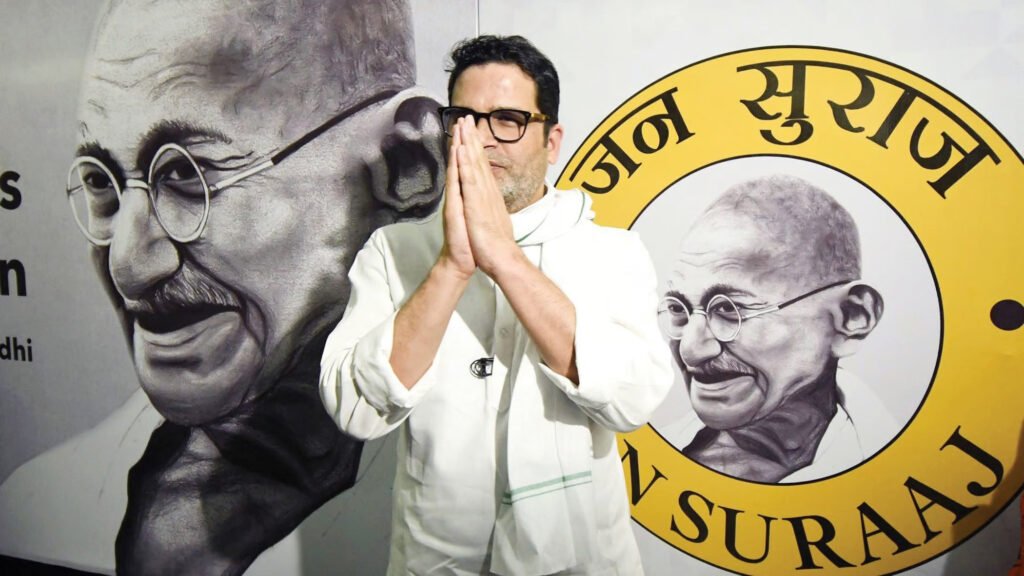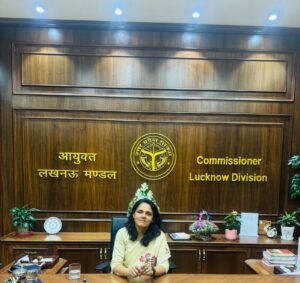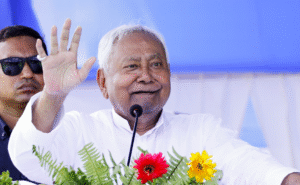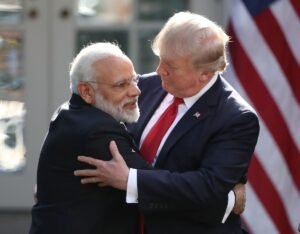Can Prashant Kishore shake up the scene in Bihar ?

Patna: Prashant Kishore’s rise in Indian politics is a fascinating journey that reflects his strategic acumen and ability to transform political campaigns.

Prashant Kishore began his career as a public health expert, working with international organizations like the United Nations. However, his foray into politics happened around 2011 when he worked behind the scenes with Indian politicians, blending his expertise in data analytics and grassroots mobilization.

Kishore shot to fame with his role in Narendra Modi’s 2014 general election campaign. He was the architect of the “chai pe charcha” initiative and other innovative strategies that helped Modi connect with millions of voters. His firm, Citizens for Accountable Governance (CAG), played a pivotal role in crafting Modi’s image as a development-focused leader. The massive victory of the BJP in 2014 placed Kishore on the political map as a master strategist.
After his success with Modi, Kishore shifted his focus to Bihar and helped craft the Grand Alliance (Mahagathbandhan) between Nitish Kumar’s JD(U), Lalu Prasad Yadav’s RJD, and Congress for the 2015 Bihar Assembly elections. Despite the BJP’s dominance in the 2014 elections, Kishore’s strategic planning helped this coalition win a landslide victory. This win solidified his reputation as a political game-changer.
Following these successes, Kishore founded the Indian Political Action Committee (I-PAC), a political consultancy firm that provides data-driven campaign strategies to political parties. I-PAC became an influential player in Indian elections, bringing in a new model of professional political consultancy in a country where such roles were mostly handled by party insiders.
In 2017, Kishore was appointed to help Congress in the Uttar Pradesh elections, though the party performed poorly. He faced setbacks during this period, but his ability to bounce back was evident when he played a crucial role in the 2021 West Bengal Assembly elections, helping Mamata Banerjee’s Trinamool Congress (TMC) secure a decisive victory against a high-voltage BJP campaign. His “Bengal first” campaign successfully captured regional sentiment, establishing Kishore’s knack for understanding local dynamics.
Prashant Kishore’s I-PAC also worked with YSR Congress Party (YSRCP) in Andhra Pradesh, leading to a sweeping victory for Jagan Mohan Reddy in 2019. In Tamil Nadu, he helped the DMK (Dravida Munnetra Kazhagam) win the 2021 state elections, proving his ability to shape electoral outcomes in diverse political landscapes.

Despite his success as a strategist, Prashant Kishore decided to shift focus to active politics. In 2018, he officially joined the JD(U) led by Nitish Kumar and was made the party’s vice president. However, his relationship with Nitish soured due to differences over the CAA-NRC policies, leading to his expulsion from the party in 2020.
Kishore eventually announced his political ambitions through the Jan Suraj (Good Governance) Movement in Bihar, marking a departure from his role as a behind-the-scenes strategist to an active political participant. This initiative focuses on addressing grassroots issues, and his aim is to build a new political platform independent of caste-based or identity politics. Kishore’s “Padayatra” (foot march), a key element of his strategy, is meant to engage with people at the ground level and understand their problems directly.
Prashant Kishore is now entering a new phase where he is positioning himself as a political alternative, especially in his home state of Bihar. His grassroots campaigns are geared toward long-term political engagement, aiming to reshape the state’s political discourse by focusing on development, education, health, and governance rather than traditional caste-based politics. Prashant Kishore’s entry into Bihar politics is poised to have a significant impact on the state’s political landscape. Here’s how it could unfold:
1. Emergence of a Third Force
Prashant Kishore has distanced himself from established political parties like the BJP, RJD, and JD(U) in Bihar. His focus on “Jan Suraj,” a movement aimed at grassroots mobilization, may introduce a new, independent political force. This could appeal to voters disillusioned with traditional party politics, creating a viable alternative to the current power structures.
2. Youth and Aspirational Voter Base
Kishore’s strategy often revolves around connecting with young and aspirational voters, a demographic that is growing in Bihar. His emphasis on governance, development, and transparency may attract younger voters who are looking for fresh leadership, moving away from caste-based and identity politics, which dominate Bihar’s political scene.

3. Challenge to Established Parties
Both Nitish Kumar’s JD(U) and Tejashwi Yadav’s RJD have been dominant forces in Bihar. Kishore’s political plunge could challenge their hegemony. By focusing on grassroots development and directly addressing local issues, he could chip away at the support bases of these parties, particularly in regions where governance has been criticized.
4. Data-Driven Campaigning
Known for his expertise in election strategies, Kishore’s approach will likely be highly data-driven and focused on local issues. This could change the way elections are fought in Bihar, making political campaigns more targeted and less reliant on traditional vote-bank politics. His campaigns may emphasize governance, education, healthcare, and employment, areas where Bihar has often lagged.
5. Caste Dynamics
Bihar’s politics is deeply entrenched in caste dynamics, and while Kishore’s movement is largely issue-based, navigating this landscape will be a key challenge. If he manages to appeal across caste lines, his entry could disrupt the long-standing equations between dominant castes like Yadavs (RJD’s core base) and Kurmis (JD(U)’s core base).
6. Long-Term Political Shifts
Even if Kishore does not immediately succeed in gaining significant electoral traction, his involvement in Bihar’s politics could instill long-term shifts. His focus on development over identity politics could encourage the larger political discourse in the state to move in that direction.
7. Impact on 2025 Assembly Elections
The true test of Kishore’s political impact will be the 2025 Bihar Assembly elections. If his movement gains traction among key demographics such as youth and lower castes, it could reshape the electoral landscape. Even small electoral gains could position him as a kingmaker in case of a hung assembly or tight competition.
In summary, Prashant Kishore’s entry into Bihar politics has the potential to disrupt the current political order by introducing development-focused, data-driven politics, appealing especially to youth and disillusioned voters. His success will depend on his ability to navigate caste politics and establish his movement as a credible alternative to entrenched parties.
Prashant Kishore’s rise is unique because it is not based on traditional politicking but on modern political consultancy, leveraging data, media, and public perception. His ability to pivot from behind-the-scenes strategist to active politician could transform how politics is done in India, especially in states like Bihar, where he is now seeking to create a fresh political narrative.
He joins a league of political players
In the past decade, India has witnessed the emergence of several new political outfits, reflecting shifts in the country’s political landscape. These parties, often founded by leaders with distinct visions, have sought to challenge established power structures, addressing regional, ideological, or governance issues. Here’s an overview of notable political parties launched over the last ten years:
Aam Aadmi Party (AAP) – 2012
- Founder: Arvind Kejriwal
- Background: Born out of the anti-corruption movement led by Anna Hazare, the AAP was launched to combat systemic corruption in Indian politics. Initially centered on Delhi, the party saw Arvind Kejriwal rise to power as Delhi’s Chief Minister after sweeping victories in the 2015 and 2020 assembly elections.
- Impact: The party has expanded its footprint in states like Punjab (winning the 2022 Assembly elections), and is positioning itself as an alternative to the BJP and Congress at the national level. Its focus on governance reforms, education, and health care has been central to its rise.
Telangana Rashtra Samithi (TRS) Becomes Bharat Rashtra Samithi (BRS) – 2022
- Founder: K. Chandrashekar Rao
- Background: Originally launched in 2001 as TRS to demand a separate state of Telangana, the party achieved this goal in 2014 with the formation of Telangana. In 2022, KCR rebranded TRS as Bharat Rashtra Samithi (BRS), positioning it as a national party with aspirations beyond Telangana.
- Impact: With its new avatar, BRS aims to challenge the BJP’s dominance, particularly in South India. It is attempting to broaden its appeal by focusing on national-level governance, economic policies, and social justice.
Yuvajana Sramika Rythu Congress Party (YSRCP) – 2011
- Founder: Y. S. Jagan Mohan Reddy
- Background: Formed by Jagan Reddy after a fallout with the Indian National Congress following the death of his father, Y. S. Rajasekhara Reddy, the YSRCP rose to prominence by capitalizing on Jagan’s popularity in Andhra Pradesh.
- Impact: YSRCP’s sweeping victory in the 2019 Andhra Pradesh Assembly elections made Jagan the Chief Minister. The party has a strong focus on welfare schemes and social justice, dominating the state’s political landscape.
All India N.R. Congress (AINRC) – 2011
- Founder: N. Rangasamy
- Background: Launched after Rangasamy’s split from the Indian National Congress, the AINRC quickly gained power in Puducherry. The party appeals primarily to regional aspirations and focuses on welfare politics.
- Impact: The AINRC has remained a major player in Puducherry politics, securing a stronghold in successive elections.
Makkal Needhi Maiam (MNM) – 2018
- Founder: Kamal Haasan
- Background: Kamal Haasan, a celebrated actor, launched MNM to provide an alternative to Tamil Nadu’s dominant Dravidian political parties. Haasan has focused on anti-corruption, development, and the welfare of the Tamil people.
- Impact: While MNM has yet to secure major electoral victories, it has drawn attention for its celebrity-backed agenda and the potential to influence future Tamil Nadu politics by targeting urban voters and middle-class aspirations.
Jana Sena Party (JSP) – 2014
- Founder: Pawan Kalyan
- Background: Another South Indian film star, Pawan Kalyan, launched the JSP with the aim of representing the common people (Jana Sena translates to “People’s Army”). The party focuses on youth issues, social justice, and anti-corruption.
- Impact: While the party hasn’t achieved significant electoral success, it has built a dedicated support base in Andhra Pradesh, particularly among youth and the Kapu caste. Pawan Kalyan’s charisma continues to keep the party relevant in regional politics.
Azad Samaj Party – 2020
- Founder: Chandrashekhar Azad (Bhim Army)
- Background: Chandrashekhar Azad, a prominent Dalit leader and activist, founded the Azad Samaj Party as an extension of his Bhim Army movement, which focuses on the rights of Dalits and other marginalized communities.
- Impact: The party has emerged as a strong voice for Dalit rights, particularly in Uttar Pradesh. While still nascent, it seeks to galvanize support among the Dalit population and challenge established political parties in North India.
Krantikari Jaihind Sena – 2020
- Founder: Rajesh Ranjan (Pappu Yadav)
- Background: Pappu Yadav, a former RJD leader, launched Krantikari Jaihind Sena after leaving the Jan Adhikar Party, aiming to provide a voice to underrepresented groups in Bihar.
- Impact: The party is a regional player, focused on addressing social and economic issues, especially in rural Bihar, and challenges the dominance of caste-based parties in the state.
Tipraha Indigenous Progressive Regional Alliance (TIPRA) – 2021
- Founder: Pradyot Bikram Manikya Debbarma
- Background: TIPRA, launched by the royal scion of Tripura’s erstwhile monarchy, focuses on the rights and interests of indigenous communities in Tripura, particularly pushing for a “Greater Tipraland” to address tribal autonomy.
- Impact: TIPRA has gained considerable momentum in Tripura, becoming a dominant force in tribal politics and challenging both the BJP and CPI(M).
Tirnamool Congress Expansion and Growth – West Bengal
- While not a new party, Mamata Banerjee’s Trinamool Congress (TMC) has significantly expanded beyond West Bengal in recent years. It has entered electoral contests in states like Goa and Tripura, positioning itself as a national alternative to the BJP and Congress. Its attempt to grow beyond Bengal reflects broader ambitions as a pan-India regional party.
Trends Observed:
- Regionalism: Many of the new political outfits are regional in nature, formed to address local or state-specific concerns. Parties like YSRCP, BRS, and TIPRA focus on regional aspirations, often rooted in identity, cultural, or economic issues.
- Celebrity Founders: Several parties have been launched by prominent figures from the entertainment industry, such as Kamal Haasan (MNM) and Pawan Kalyan (JSP), capitalizing on their mass appeal.
- Dalit and Marginalized Community Politics: The rise of parties like the Azad Samaj Party signals the emergence of new platforms for marginalized communities, challenging the dominance of mainstream parties in advocating for social justice.
- Non-Traditional Politics: Parties like AAP and MNM reflect a trend of non-traditional politics, emphasizing governance, transparency, and anti-corruption over the identity politics and traditional rhetoric often seen in Indian elections.
Overall, the last decade has been marked by the rise of regional, ideologically distinct parties in India, often disrupting traditional party dynamics and offering voters more localized or issue-based choices. These political outfits, whether successful or not, reflect India’s ever-evolving democratic experiment.








